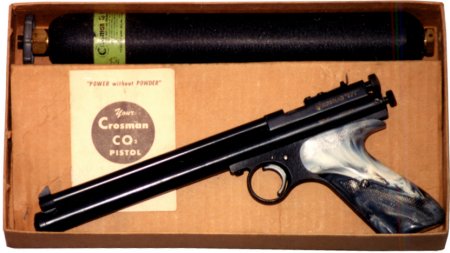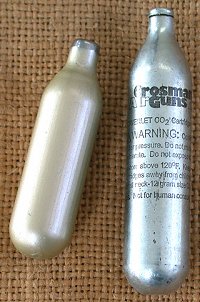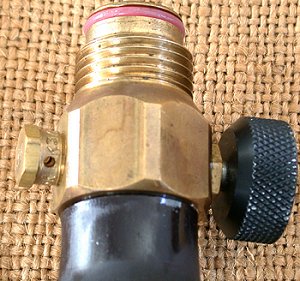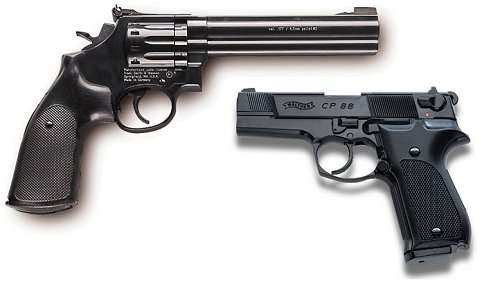*Offer expires 04/30/24 at 3 a.m. ET. Some exclusions apply.
*Offer expires 04/30/24 at 3 a.m. ET. Some exclusions apply.
By Tom Gaylord
exclusively for PyramydAir.com. © Copyright 2003 All Rights Reserved
 In the 1940s, Crosman adapted 4-oz. military CO2 bottles to their "Silent" pneumatic rifle, which is the gun that collectors now call the CG (compressed gas). They never sold them to the public. They were part of a shooting gallery marketing plan Crosman pursued for a few years after WWII. The guns came with a tank that hung straight down (as shown) and one that hung slanted to the rear. They were made in a proprietary .21 caliber as well as the more conventional .22. This was America's first CO2 airgun experience |
 Crosman has now come full circle and is offering a bulk-filled CO2 rifle once again. This 1077 is adapted to use the new 3.2-oz. AirSource bottle, as well as conventional 12-gram powerlets. With the AirSource bottle attached, hundreds of shots are available. A valve permits removal while the bottle still has gas. |
 After the CG guns, Crosman brought out a series of bulk-filled CO2 pistols and rifles that lasted into the mid-1950s. This .177 model 111 still has its original box, 10-oz. bulk tank and instruction manual. The gun was holding gas when I purchased it at a flea market! |
 The small 8-gram cartridge known as a Sparklet is dwarfed by the more popular 12-gram powerlet from Crosman. Since Crosman invented the 12-gram size, the term powerlet now applies to all cartridges of that size, regardless of who makes them. |
 DOT regulations require the use of a burst disk in pressure vessels larger than two inches in diameter. The brass nut with the hole in the side contains the burst disk in this bulk CO2 tank. If pressure inside the tank rises above the safety level, the disk ruptures, releasing all the gas inside. That keeps the entire bulk tank from exploding with the force of a bomb. |
 Umarex, the company that owns Walther of Germany, makes several realistic CO2-powered copies of famous firearms. The S&W 586 revolver will shoot faster than the Walther CP88 pistol because it has a longer barrel. |
Buy With Confidence
Get FREE shipping on qualifying orders! Any order $150+ with a shipping address in the contiguous US will receive the option for free ground shipping on items sold & shipped by Pyramyd AIR during checkout. Certain restrictions apply.
Free shipping may not be combined with a coupon unless stated otherwise.
View Shipping Info
We work hard to get all orders placed by 12 pm EST out the door within 24 hours on weekdays
because we know how excited you are to receive your order.
Weekends and holiday shipping times will vary.
During busy holidays, we step our efforts to ship all orders as fast as possible,
but you may experience an additional 1-2 day delay before your order ships.
This may also happen if you change your order during processing.
View Shipping Times
It's important to know that due to state and local laws, there are certain restrictions for various products.
It's up to you to research and comply with the laws in your state, county, and city.
If you live in a state or city where air guns are treated as firearms you may be able to take advantage of our FFL special program.
U.S. federal law requires that all airsoft guns are sold with a 1/4-inch blaze orange muzzle
or an orange flash hider to avoid the guns being mistaken for firearms.
View Shipping Restrictions
Get the most out of your equipment when you work with the expert technicians at Pyramyd AIR. With over 25 years of combined experience, we offer a range of comprehensive in-house services tailored to kickstart your next adventure.
If you're picking up a new air gun, our team can test and tune the equipment before it leaves the warehouse. We can even set up an optic or other equipment so you can get out shooting without the hassle. For bowhunters, our certified master bow technicians provide services such as assembly, optics zeroing, and full equipment setup, which can maximize the potential of your purchase.
By leveraging our expertise and precision, we ensure that your equipment is finely tuned to meet your specific needs and get you ready for your outdoor pursuits. So look out for our services when shopping for something new, and let our experts help you get the most from your outdoor adventures.
View Service Info
Shop and purchase with confidence knowing that all of our air guns (except airsoft) are protected
by a minimum 1-year manufacturer's warranty from the date of purchase unless otherwise noted on the product page.
A warranty is provided by each manufacturer to ensure that your product is free of defect in both materials and workmanship.
View Warranty Details
Didn't get what you wanted or have a problem? We understand that sometimes things aren't right and our team is serious about resolving these issues quickly. We can often help you fix small to medium issues over the phone or email.
If you need to return an item please read our return policy.
Learn About Returns
Get FREE shipping on qualifying orders! Any order $150+ with a shipping address in the contiguous US will receive the option for free ground shipping on items sold & shipped by Pyramyd AIR during checkout. Certain restrictions apply.
Free shipping may not be combined with a coupon unless stated otherwise.
View Shipping Info
Want More?
Join Our Email List for News and Deals!
Join the Pyramyd AIR mailing list: Our e-mails are filled with new products, deals, sneak peeks, tips and tricks, contests and more - sign up today!
Text JOIN to 91256 and get $10 OFF Your Next $50+ Order!
* By providing your number above, you agree to receive recurring autodialed marketing text msgs (e.g. cart reminders) to the mobile number used at opt-in from Pyramyd AIR on 91256. Reply with birthday MM/DD/YYYY to verify legal age of 18+ in order to receive texts. Consent is not a condition of purchase. Msg frequency may vary. Msg & data rates may apply. Reply HELP for help and STOP to cancel. See Terms and Conditions & Privacy Policy.